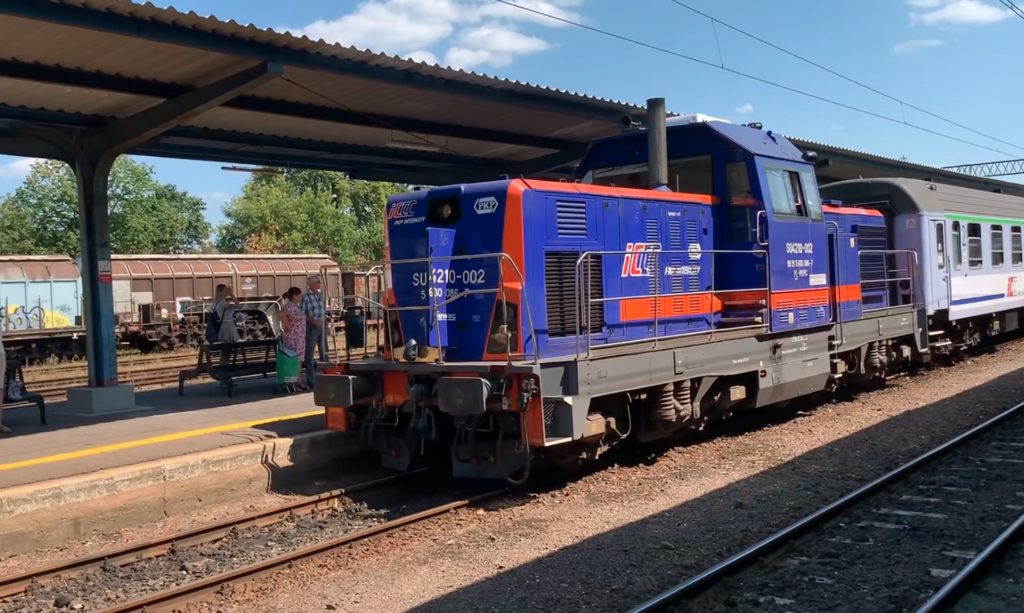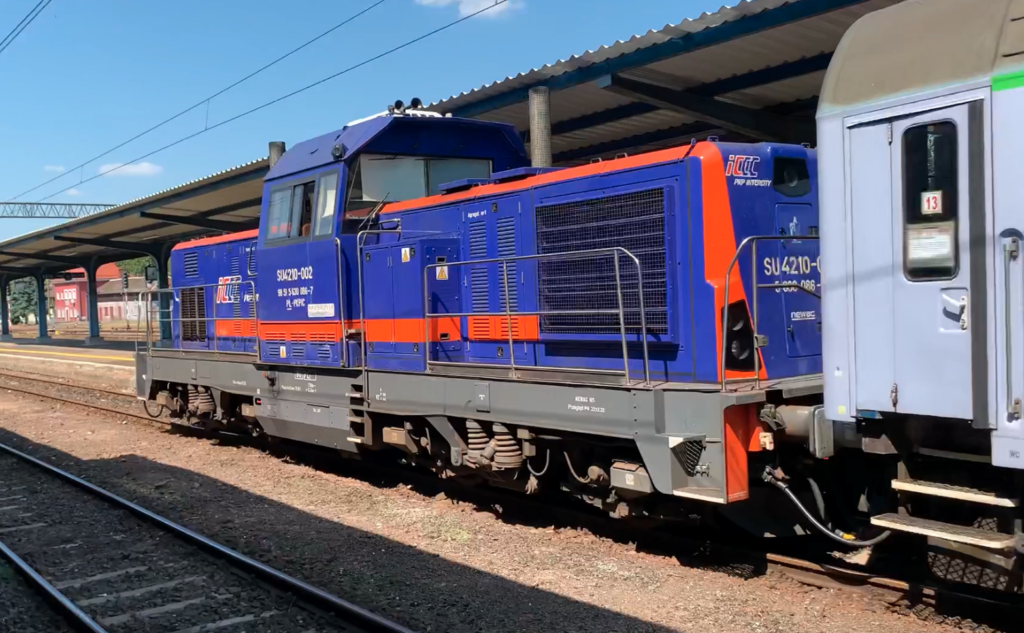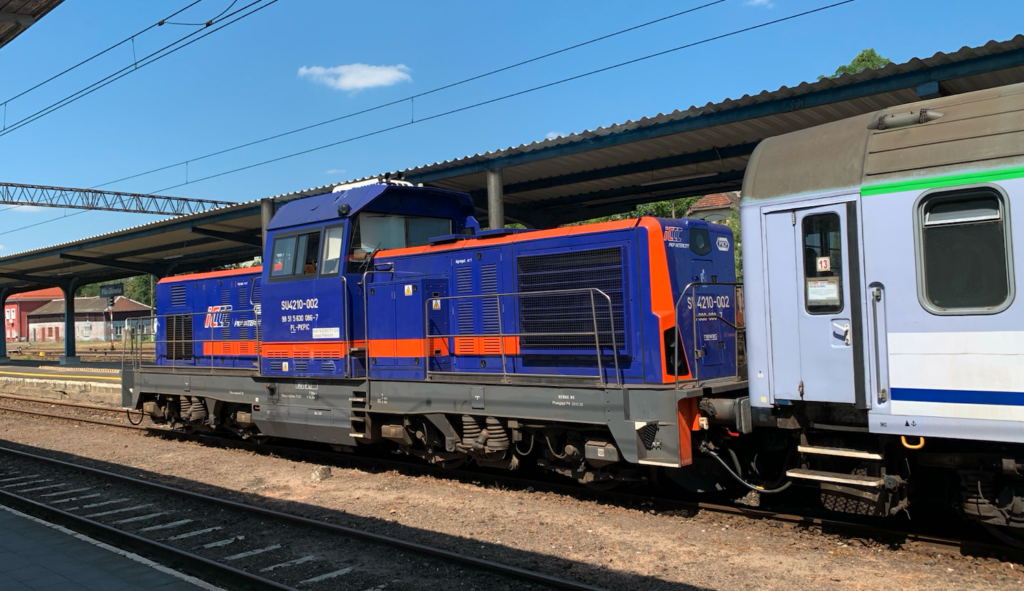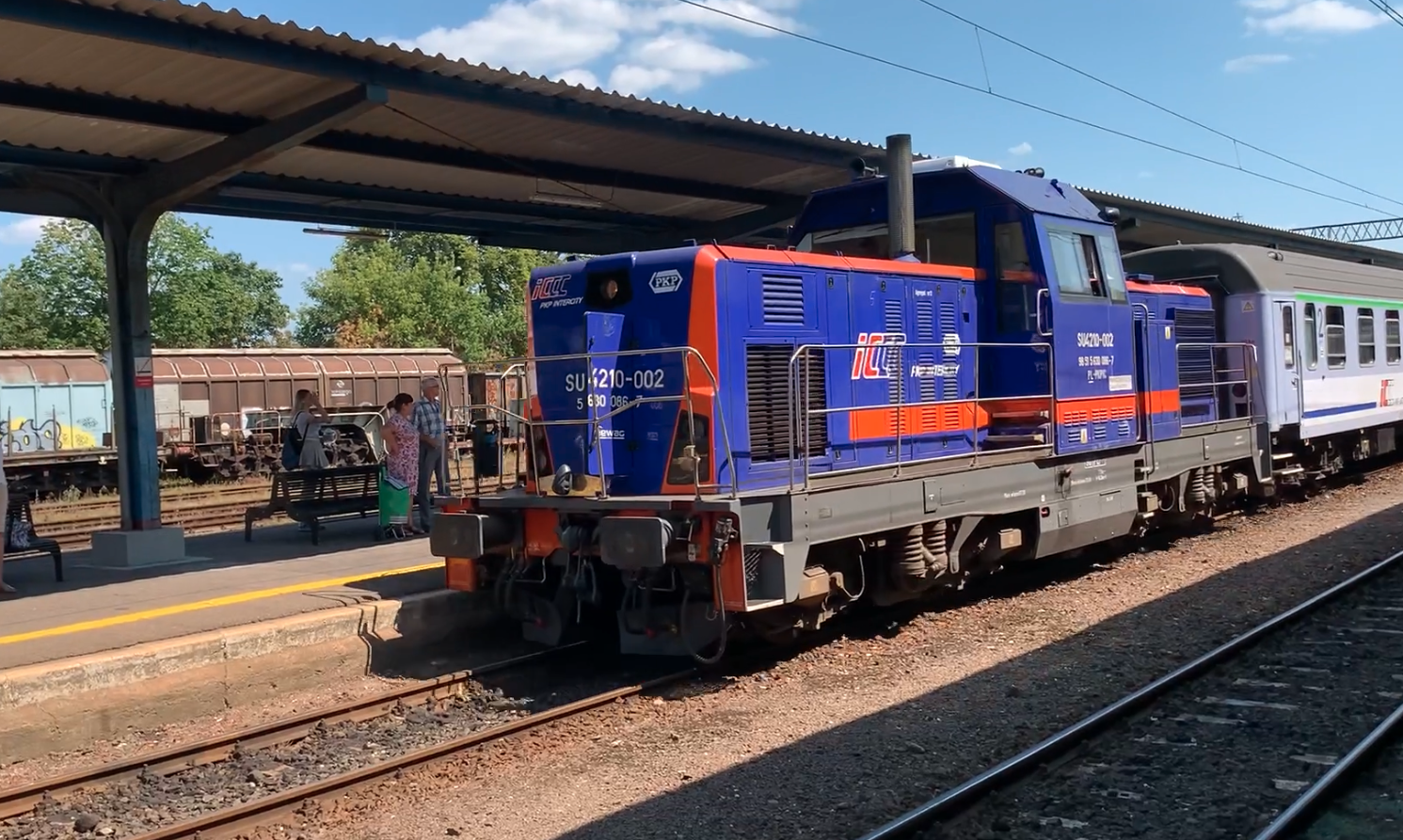Piła 16-08-2024
Diesel locomotive NEWAG SU4210-002.
The SU4210-002 locomotive comes from a copy of the SM42 locomotive, which was built in 1973. At that time, it received the serial number 6D-8805/1973 and the designation SM42-643. After its service, the locomotive was designated for scrapping (2013), which was not done. In 2015, the locomotive was sent for deep modernization, which was performed at NEWAG in Nowy Sącz. The reconstruction of the locomotive was completed in March 2015. At that time, the locomotive received the designation SU42-1002, which was eventually changed to SU4210-002.
As a new locomotive, the vehicle was sent to work at PKP InterCity. Initially, the locomotive was sent to work in Wrocław, then (April 2018) in the Western Plant in Poznań, then (June 2020) on delegation to the Northern Plant in Gdynia. From December 2022, permanently in the Northern Plant in Gdynia.
The NEWAG SU4210-002 locomotive served InterCity trains in Lower Silesia, and since 2016, in Pomerania. The locomotive pulled trains on the following routes: IC “Śnieżka” Kudowa Zdrój – Warszawa Wschodnia. TLK “Wydmy” Hel – Bohumin. TLK “Kormoran” Polanica Zdrój – Olsztyn Główny. IC “Zamoyski” Gorzów Wielkopolski – Piła Główna – Hrubieszów Miasto. In 2024, the locomotive mainly served TLK “Bory Tucholskie” Kostrzyn – Gdynia Główna trains.
The InterCity carrier ordered 10 6Di locomotives (SU4210), which received the designations 6Di-001 – 6Di-010. The locomotives were built by NEWAG in 2014-2015.



NEWAG 6Di (SU4210) locomotives.
PKP IntrCity, together with 18D type locomotives (with the option of running on battery power), ordered 10 6Di type locomotives from NEWAG. As in the case of 18D type locomotives, this was to be a complete conversion of the used SM42 locomotives.
The modernization of the 6Di locomotive consists of installing two generators instead of one. The locomotives are designed for passenger trains on non-electrified routes. In the summer, when passenger traffic is greater, the new locomotive is to use both generators to pull trains consisting of 5-6 passenger cars. In the winter, when passenger traffic is lower, the locomotive pulls a train consisting of 2-3 passenger cars using one generator. The second generator provides electric heating for the cars.
The agreement between InterCity and NEWAG was concluded in September 2013. In October 2013, design work began, and then construction of the first locomotive began. In July 2014, the first locomotive was ready and tests were conducted on the experimental track. In August 2014, the locomotive was taken over by InterCity.
Locomotives upgraded to 6Di:
SU42-1001 delivered August 2014, previously SM42-576 built in 1973.
SU42-1002 delivered January 2015, previously SM42-643 built in 1973.
SU42-1003 delivered January 2015, previously SM42-179 built in 1969.
SU42-1004 delivered March 2015, previously SM42-574 built in 1973.
SU42-1005 delivered March 2015, previously SM42-1008 built in 1978.
SU42-1006 delivered April 2015, previously SM42-429 built in 1971.
SU42-1007 delivered April 2015, previously SM42-189 built in 1969.
SU42-1008 delivered April 2015, previously SM42-563 built in 1973.
SU42-1009 delivered May 2015, previously SM42-604 built in 1973.
SU42-1010 delivered May 2015, previously SM42-530 built in 1972.
6Di design (SU4210).
In March 2021, on route No. 403 Piła – Wałcz – Kalisz Pomorski – Ulikowo, four pairs of PolRegio passenger trains and one pair of TLK 28100 “Staszic” ran on the Lublin Główny — Szczecin Główny route. The TLK 28100 “Staszic” train on tracks without electrification was pulled by a PESA SU160 Gama diesel locomotive. In the absence of these locomotives, the train was pulled by the SM42 locomotive, which is slower, and this generated delays. SM42 works well with two wagons, but 5-6 wagons is a problem. Currently, only 10 PESA SU160 Gama locomotives run on Polish tracks. They cover routes in the Lublin region and Pomerania. This difficult situation has been since the withdrawal of the SU45 (HCP 301D) and SU46 locomotives from exploration. The new NEWAG 6Di locomotives have largely solved the problem of trains on unelectrified routes. In PKP InterCity, the locomotives have received a new designation SM4210.
The design of the NEWAG 6Di locomotive was based on experience gained during the construction of 6Dg and 18D locomotives. Due to the use of two identical aggregates, the locomotive looks identical from both ends. The driver’s cab was placed in the very center. As with the previous two locomotives, it was equipped with two driver’s positions.
The process of rebuilding the SM42 (6D) locomotive into the SM4210 (6Di) locomotive began with the dismantling of the entire locomotive body, of which only the frame, fuel tanks and driving bogies remained. The driving bogies, rolling wheels and engines were overhauled. The locomotive frame was modified to accommodate two new aggregates and a driver’s cab. New bumpers with a “crash” function were installed in the end carriages, which absorb significant impact energy.
Each unit consists of an American CATERPILLAR C18 engine with a power of 563 kW (765 HP), which is connected to a set of synchronous generators via a flexible clutch. Nominal speed 1,800 rpm. Each unit has its own air intake system and exhaust system. Diesel particulate filters of the DOC type have been used in the engine exhaust systems to meet European standards. Each unit can operate as a drive or as an electric railcar heating system. This is decided by the driver. The heating system is powered by a special converter mounted on the platform in the container. The headers have heating system sockets compliant with the UIC 522 card. The starter motor of the combustion engines is powered by a supercapacitor system, which allows for reducing the power of the batteries.
The locomotive body is made of steel, except for the front panels, which are made of plastic. The 6Di locomotive uses traction motor fans powered by electric motors for the first time. These motors and the electric motors of the auxiliary systems are powered by inverters. The braking system is supplied with air from two screw compressors. The parking brake is a classic, spring-loaded type.
A completely new driver’s cabin was designed for the 6Di locomotive, equipped with two ergonomic separate driver’s stations, for forward and reverse travel. The stations are equipped with comfortable folding seats. The control panels are similar to those in the new locomotives. Thanks to the low hood of the locomotive, visibility from the cabin is very good, and the cabin has panoramic windows. The cabin is lit with LED light and has heating and air conditioning. The cabin can be equipped with a cupboard, sink, refrigerator, hotplate and microwave. The sink has hot water. The entrance to the cabin is provided by a door, which is accessible from the bridge around the locomotive. The cabin is 30% larger than the old one. The cabin walls are lined with plastic panels. Additionally, the cabin is separately sprung, by setting it on rubber shock absorbers.
To improve safety, the driver has cameras aimed at both couplers of the locomotive. The image from the cameras is recorded. Additionally, the locomotive is equipped with a digital monitoring system, the data of which is presented on an LCD touch screen in the driver’s cabin. The 6Di locomotive is approved for one-person traction operation.
It seems that the only drawback of the 6Di locomotive is the maximum speed of only 90 km/h. However, considering the routes on which they operate, there is no problem.
The 6Di locomotive (SM4210) is very modern and has little in common with the classic SM42. The locomotive has microprocessor control and extensive diagnostics. There are inverters in the control system. A modern starting system that allows the engine to ignite even at very low temperatures. The driver’s comfort is very high, and the social facilities in the cabin exceed previous standards. Visibility from the cabin is very good and significantly exceeds what was in the old cabin. Fuel consumption is significantly reduced. Total operating costs are also lower. The designer managed to improve the traction parameters of the locomotive. The power of the 6Di locomotive (1,530 HP) is almost twice that of the classic 6D (800 HP). Currently (August 2024), NEWAG does not offer 6Di locomotives. However, there are 6Dg and 15/16D locomotives.
T-T data of the NEWAG 6Di type locomotive:
Bo’Bo’ axle arrangement. 1LN type bogies. ISA 430 traction motors, with a power of 4 x 173 kW. Service weight 71,800 kg. Maximum load on one axle 17,500 kg. Wheel diameter 1.10 m. Total length 14.24 m. Width 3.13 m. Height 4.40 m. Maximum speed 90 km/h. Main brake Knorr-Bremse. Compressor type – Screw KNORR SL40. Parking brake – spring.
Written by Karol Placha Hetman

Leave a Reply
You must be logged in to post a comment.